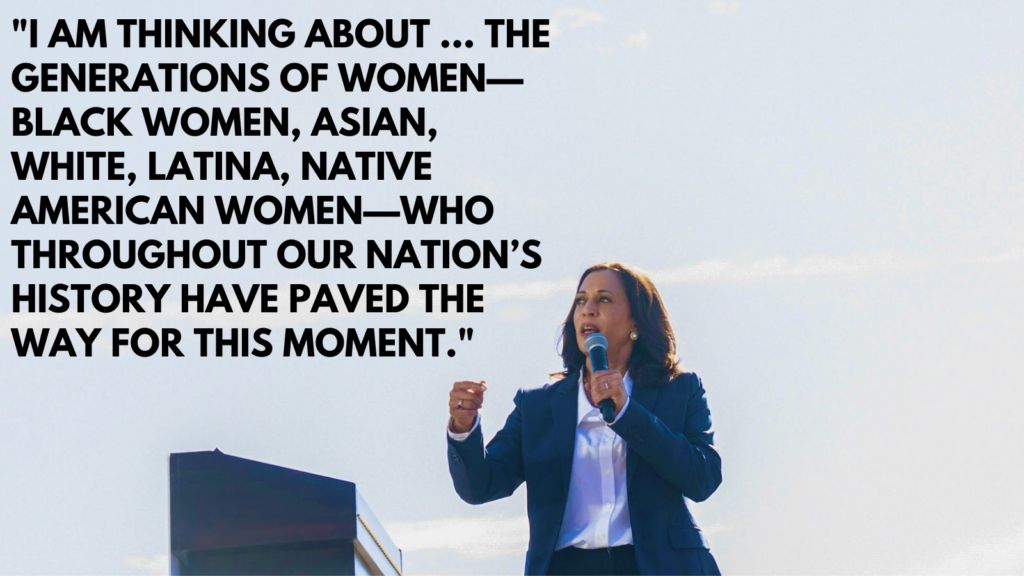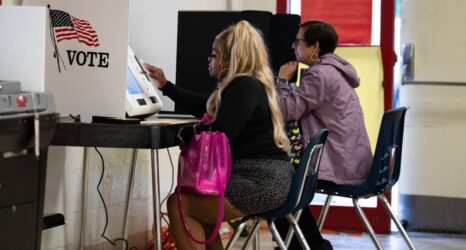1. The 2020 elections were a historic moment for women in politics with the election of Kamala Harris, the first woman who is also Black and South Asian, to be elected vice president.

A feminist, Vice President-Elect Harris made important points in her acceptance speech:
“I am thinking … about the generations of women, Black women, Asian, white, Latina, Native American women, who throughout our nation’s history have paved the way for this moment tonight.
“Women who fought and sacrificed so much for equality and liberty and justice for all, including the Black women who are too often overlooked, but so often prove they are the backbone of our democracy.”
Harris also acknowledged “all the women who have worked to secure and protect the right to vote for over a century.”
“Tonight,” she said, “I reflect on their struggle, their determination, and the strength of their vision to see what can be unburdened by what has been. And I stand on their shoulders.”
2. In Congress, women continued to make incremental increases in women’s representation to elected office.
According to the Center for American Women and Politics (CAWP), at least 138 (104D, 34R) women will serve in the 117th Congress. This is a new record. There are 17 congressional races featuring women candidates that remain too close to call and one race that will be decided by a runoff election on Jan. 5.
- Twenty-four women (16D, 8R) will serve in the U.S. Senate (current record: 26 set in 2020), including 3 (D) women of color. This does not include California Senator Kamala Harris, who will ascend to the vice presidency. Senator Kelly Loeffler (R-Ga.) has advanced to a runoff in the special election for the seat she was previously appointed to, taking place after the new Congress is sworn in.
- At least 114 (88D, 26R) women will serve in the U.S. House (previous record: 102 set in 2019), including 44 (42D, 2R) women of color. Women will be at least 25.5 percent of all members of the U.S. House. Women are currently 23.2 percent of House members in 2020. At least 45 (42D, 3R) women of color will serve in the U.S. House (current record: 44 set in 2019).
(Read more about countless firsts made this year for people of color, LGBTQ+ candidates and women.)
3. Gender gaps in the battleground states favored Joe Biden and Kamala Harris.
Surveys among people who voted by mail or in-person before or on Election Day, by both Edison Research and the Associated Press/NORC at the University of Chicago, show gender gaps, the difference between women and men voters.
The gender gap was decisive in key battleground states, ranging from seven points in Arizona, 10 points in Pennsylvania, 12 points in Wisconsin and 15 points in Michigan. The national gender gap of 12 points was decisive, with a majority of women voting for Biden/Harris (57 percent) while a majority of men voted for Trump/Pence (53 percent).
4. Black women were a key driver of the gender gap.
Ninety-percent of Black women voted for Biden/Harris, making this the largest proportion of any one group of women, as compared to young women, single women, other racial groups and urban, suburban or rural voters. Black women voters helped fuel Joe Biden’s resurgence in the early primary states, and continued organizing get out the vote (GOTV) efforts up through Election Day across the country and in key states like Georgia and Pennsylvania.
In fact, the Associated Press reported that 38 percent of Biden’s support came from voters of color.
4. Women and feminists saw multiple successes when it came to state ballot measures.
Coloradans passed Proposition 118 by a margin of 57 percent to 42 percent, creating a paid medical and family leave insurance program in the state.
“Colorado has made history as the tenth state—including D.C.—in the country to pass paid family and medical leave and the first to pass it through a ballot measure. This win shows the immense public support for safety net programs like paid family and medical leave,” said Ashley Panelli, Colorado 9to5 paid leave campaign manager and a leader in the Colorado coalition Yes on 118. “I’m optimistic that we have set a precedent for local and national advocates across the country to follow, and that one day soon we will guarantee paid leave for all.”
By a margin of 59 percent to 41 percent, Colorado voters also protected abortion access later in pregnancy by defeating Proposition 115, which would have effectively prohibited abortions after 22 weeks.
“For the fourth time in 12 years, Coloradans have rejected attempts to ban abortion at the ballot, trusting patients and families to make the personal medical decisions that are right for them, without interference from politicians,” Lucy Olena, campaign manager for the No on 115 campaign, said in a statement.
Alas, women in Louisiana weren’t so lucky: In a huge blow for reproductive rights, Louisiana voters passed Amendment 1 by a margin of 62 percent to 37 percent. The amendment adds a sentence to the state’s Declaration of Rights indicating it does not protect the right to an abortion—making it nearly impossible to keep abortion legal in the state if Roe v. Wade is overturned.
Voters in Oregon’s Multnomah County—which includes Portland—passed one of the most progressive universal preschool policies in the U.S. by a wide margin of 64 percent to 34 percent. As the name indicates, “Preschool for All” will provide free preschool for three- and four-year-olds in the county, as well as raise wages for preschool teachers—most of whom are women and, disproportionately, women of color. It will be funded by a marginal income tax on high income earners.
In a huge win for worker’s rights, Florida voters passed Amendment 2, which will increase the minimum wage to $15 by 2026. A 60 percent supermajority was required to pass the amendment—and it just made the cut, with 60.81 percent voting in favor, and 39 percent of voters opposed.
Nevada made history this year: Sixty-three percent of Nevadans voted yes to support Question 4, making it the first state to include a Voter’s Bill of Rights in their constitution.
By 62 percent to 37 percent, Nevada voters also approved Question 2, which would recognize marriage between couples regardless of gender.
NOTE: The many reports and commentaries on voting trends are based on “preliminary” polling done by Edison and AP/NORC that include a representative sample of 10,000+ interviews of people who cast ballots before and on election day. In Spring 2021, the U.S. Census Bureau will release its regular Voting in America series that will provide more detailed information.
You may also like:





